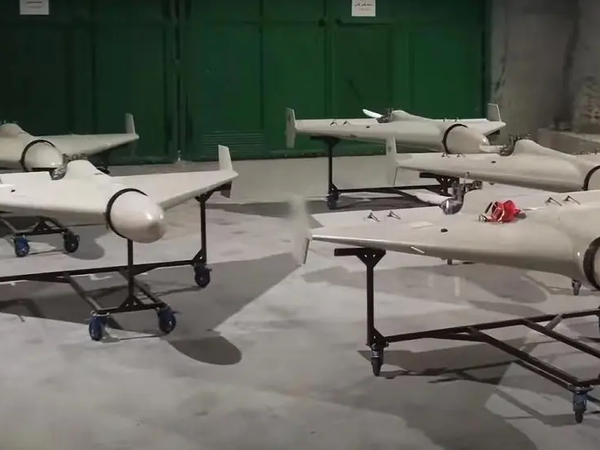As Russia's full-scale invasion of Ukraine hits the 1,000-day mark and North Korean troops take to the field to support the campaign, Iran International revisits the key role Iranian drones have played in the Russian war effort.
When did it start?
The first reports of Iran supplying drones to Russia emerged in July 2022. On July 11, US National Security Adviser Jake Sullivan revealed intelligence saying Iran was preparing to send several hundred drones to Russia, including those with combat capabilities.
“Our information indicates that the Iranian government is preparing to provide Russia with up to several hundred UAVs, including weapons-capable UAVs on an expedited timeline,” he told reporters.
By mid-October 2022, Ukrainian forces began identifying Iranian-made Shahed-136 drones in Russian attacks, confirming their deployment in the conflict.
Sullivan’s statement marked a pivotal moment, as it was among the earliest public indications of this emerging military collaboration. The level of specificity in the intelligence, including remarks that Iran planned to send hundreds of drones, surprised many.
How many drones were supplied?
According to the Council on Foreign Relations (CFR), Iran has supplied Russia with up to 3,000 drones - primarily the Shahed-136 model - though the exact number remains uncertain.
“Estimates vary on how many Iranian drones Russia has acquired, ranging from 600 to more than 3,000. While this number might seem large, these munitions are often used in waves, so a supply of a few thousand can be depleted in a matter of days or weeks,” the CFR wrote in October 2022.
Russia’s drone manufacturing facility
In June 2023, US intelligence alleged Iran was aiding Russia in building a drone manufacturing facility in Yelabuga, within the Alabuga Special Economic Zone on the steppes of the Tatarstan region.
The plant focuses on producing Shahed-136 drones domestically, which Russia rebranded as the Geran-2. The collaboration aims to manufacture approximately 6,000 drones by mid-2025, ensuring a consistent supply for Russia's military needs.
Iran has provided the technical expertise, blueprints, and potentially key components for the Yelabuga plant.
This facility reflected a strategic shift, allowing Russia to bypass sanctions and reduce its dependency on direct imports from Iran.
The project, however, has faced challenges, including labor shortages and logistical hurdles, prompting Moscow to scramble for workers including from among African students in the country according to the Associated Press.
How does Russia use Iranian drones?
Russian forces utilize drones like the Shahed-136 for kamikaze strikes. It means that the drones crash into fixed targets, delivering explosive payloads to damage energy grids, command centers, and supply depots.
The drone swarms are also deployed to overwhelm Ukrainian air defenses, forcing them to expend costly missiles on relatively inexpensive UAVs.
Their frequent use, particularly in nighttime attacks, creates fear among civilians and military personnel.
Iranian drones rely on GPS-guided navigation rather than first-person view (FPV) systems. This makes them cost-effective weapons but limits their adaptability to dynamic combat scenarios. Their payload capacity of approximately 40-50 kilograms and range of up to 2,500 kilometers enable strikes deep into Ukrainian territory.
Russia strategically uses drones to deplete resources, meaning drone swarms force Ukraine to expend high-value air defense missiles. Once defenses are exhausted, more advanced missile systems can reach their targets with fewer losses.
The drones also help map Ukrainian air defenses, revealing gaps for exploitation.
These tactics underscore the drones' dual role as both offensive weapons and tools for battlefield intelligence.
Efficiency and cost
Iranian drones like the Shahed-136 are considered cost-effective. Production costs range from $20,000 to $50,000 per unit, significantly cheaper than most precision-guided missiles. However, foreign buyers such as Russia pay far more—up to $290,000 per drone in smaller shipments. This pricing discrepancy reflects the added value of technology transfer and production rights.
The Shahed-136 relies on GPS for navigation, making it vulnerable to jamming. Pre-programmed flight paths limit their adaptability to dynamic combat scenarios and Ukrainian forces have increasingly intercepted these drones using advanced air defense systems, electronic jamming, and counter-drone measures.
While the exact terms of compensation remain unclear, reports suggest that Russia has made payments in cash, gold, and possibly other forms of material exchange.
In November 2022, Sky News reported that Moscow transferred €140 million in cash and captured Western weapons to Iran.
International repercussions
Iran's drone exports to Russia have drawn widespread condemnation and punitive measures, mostly from the United States and its European allies.
The US Treasury Department has sanctioned several entities involved in the production and export of Iranian drones, including Shahed Aviation Industries. Additional restrictions target logistics networks facilitating the transport of drones to Russia.
The EU has also imposed similar sanctions, focusing on Iran's drone manufacturers and individuals linked to their deployment in Ukraine. Travel bans and asset freezes have been applied to Iranian officials and companies overseeing these operations.
The controversy has led Ukraine to downgrade its diplomatic ties with Iran. Ukrainian President Volodymyr Zelenskyy has accused Tehran of complicity in Russian war crimes, while Western nations have sought to hold Iran accountable for violating arms embargoes under United Nations resolutions.
By supplying advanced UAVs and aiding domestic production, Tehran has bolstered Moscow’s capabilities in its war in Ukraine. However, the partnership has also drawn intense scrutiny, resulting in stepped-up international sanctions and heightened tensions between Iran and Western nations.
